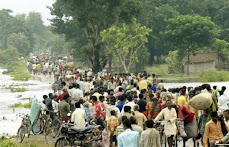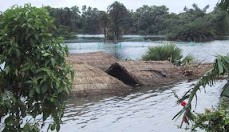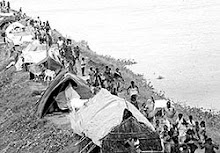Kosi basin's crisis is one of the most under-rated environmental disasters of South Asia. The Kosi treaty between India and Nepal was/is a historical blunder. It provides the basis for misplaced structural interventions in the Kosi basin. The treaty must be re-visited and must adopt a river basin approach. In India, planning for flood management commenced with the Five Year Plans, particularly with the launching of National Programme of Flood Management in 1954.
Kosi, a major tributary of Ganga of the Himalayan eco system carries the heavy load of sediment therefore, it is a mistake to build any barrage, dams and embankments on it.
Embankments have led to a rise in the level of the river-bed and the consequent elevation of the river above the level of the ground on either side, possible attacks by the river further downstream, and of course the emergence of waterlogging and even flooding in the areas ‘protected’ by the embankments because water cannot drain from those areas into the river.
Floods are natural phenomena and the disaster narrative imposed on predictable floods seems misplaced.
Besides other concerns it must be remembered that dam-and-reservoir project is rarely built exclusively for flood-control. It is generally a multiple purpose project of irrigation, power-generation, flood-control, etc.
Such a Multi-purpose Kosi High Dam project is conflict of purpose ridden because flood-control requires space for flood-waters and irrigation or power-generation would require the dam to be as full as possible. Is the proposed Kosi High dam exclusively meant for flood-control?
Indeed the sane response is that floods should be predicted, anticipated, flood-preparedness and timely evacuation.
By now the evident fallacy of ‘flood control’ is widely acknowledged fact. It is high time flood control structures are done away with in a carefully crafted manner to restore natural flooding regime step-by step in a calibrated way.
These pearls of wisdom reverberated the precincts of India International Centre and Jawaharlal Nehru University, when Dr Dinesh Kumar Mishra visited Delhi recently.
Engineering projects are politically engineered for creating the right context for fishing in the troubles waters. In the aftermath of a ritual assurance given by the Indian and Nepal Water Resources Ministers who "reassured the people of two countries of the safety of the barrage and its flood embankments," a Panel Discussion on "Floods in India: A Recurring Nightmare" at India International Centre (IIC), New Delhi on 17th July 2009 and at Jawaharlal Nehru University (JNU) on 18th July questioned such empty words and assurances which have become routine and are meant to protect the vested interests who are well entrenched in both ruling as well as opposition parties.
Projects like Kosi High Dam and interlinking of rivers are ecologically and socially disastrous, which is being promoted as the panacea of all ills by the central government, Bihar government and APJ Abdul Kalam, former President of India.
The panelists at IIC included G S Purba, Chief Engineer, flood management, River Management Wing, Central Water Commission, Dr Dinesh Kumar Mishra, a voice of sanity on the issue of drainage crisis in South Asia and a veteran civil engineer from IIT-Kharagpur besides Gopal Krishna, Convenor , Water Watch Alliance and Member, Fact Finding Mission on River Kosi. Dr Sudhirendar Sharma , Director, Ecological Foundation introduced the subject of drainage crisis in Kosi basin and the locus standi of the panelists on the issue.
The discussion happened in the backdrop of the recent visit of Pawan Kumar Bansal, Union Minister of Water Resources of India to the Kosi Embankment and barrage in Nepal and the visit of Kalam to Bihar.
Kalam appreciated the Bihar government's decision to inter-link rivers of north Bihar that would help in controlling floods and irrigate the parched lands of south Bihar. Kalam had addressed a joint session of the Bihar state legislatures in 2006 arguing for inter-linking of rivers. Such an approach has already been rejected by the Government of India's National Commission on Integrated Water Resources Management in September 1999.
Earlier, joint press release of India and Nepal dated 12 July, 2009 noted that the purpose of Bansal's visit was to undertake a joint inspection with Minister of Irrigation of Nepal Bal Krishna Khand of the repair works carried out following the breach of Kosi embankment in August 2008. The joint inspection undertaken on 12th July. The inspection team included Minister of Water Resources Bijendra Prasad Yadav of Government of Bihar, Ambassador of India in Nepal, Rakesh Sood, and Umakant Jha, Secretary, Ministry of Irrigation and other senior officials from India and Nepal.
The joint press release issued by India and Nepal government "expressed satisfaction on the timely and satisfactory execution of the Kosi breach closure works. It was a challenging task to revert the river back to barrage by constructing a diversion channel and coffer dam and then to plug the breach. This could be accomplished only through joint cooperation and close coordination between the two governments. They also inspected the repairs undertaken at other vulnerable points along the Kosi embankment and expressed satisfaction. They appreciated the level of the preparedness of the two governments, including large quantities of reserve materials and boulders stacked along the embankment and spurs to meet any exigency during the floods. The two sides have agreed to conduct round the clock patrolling of the embankments during the flood season for any emergent repair works as needed. The Nepalese side assured necessary security."
Unmindful of the havoc caused by embankments, the "Government of India is also providing assistance to Nepal for strengthening of existing and construction of new embankments along Kamala, Bagmati, Lalbakeya, Sunsari, Trijuga, Lakhadehi and Kankai rivers. The detailed project report for strengthening of embankments along Khando river is under consideration. The design and implementation of these schemes is carried out by the agencies of the Government of Nepal."
Although structural engineering measures like embankments and dams have failed, the same is being promoted by the governments in its myopia.
The discussions between the Indian and the Nepali ministers included working on long term solutions of the flood problems caused by Kosi river, which flows about 42 Kms. in Nepal after descending from the mountains and before entering India. The media has reported that these long-term solutions mean Kosi High Dam and Inter-linking od Rivers within Bihar.
Despite 207 recommendations of the National Flood Commission, 1980, at the discussions held at both at IIC and JNU, it was observed that the frequency and intensity of floods has grown in the country over the years primarily because of the increased encroachment of flood plains. It is clear that none of the recommendations have been acted upon. An environmental assessment of Kosi basin is long due to assess the damage done to it by the engineers who acted under tremendous political pressure against even their own engineering wisdom.
While Kosi crisis was declared national calamity by the Prime Minister, the Union Budget indeed aggravated the injustice done to the Kosi affected region, the engineering experiments being undertaken with political consensus of sort has turned citizens of North Bihar and Nepal into guinea pigs. It is such experiments which eventually makes migrants out of Biharis and Nepalis who face humiliation and assault all over the country.
Historically, floods and their control have never been a big issue in the Ganga-Brahmaputra basin, as it is today. Floods became a major issue after the British occupied India. When they examined the Ganga basin, they believed that if it could be made “flood-free”, they could levy a tax in return for such protection.
Tuesday, 21 July 2009
Subscribe to:
Posts (Atom)







